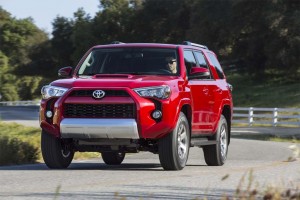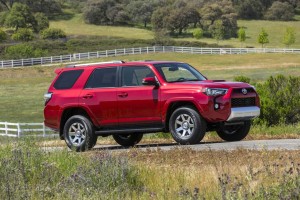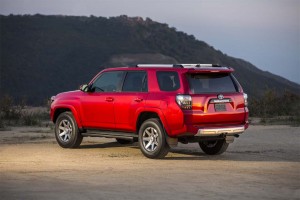Few companies have done a better job of shaking up the established order than Toyota over the last few decades. But when it comes to the new 2014 4Runner, the Japanese maker has chosen to let the world change around it, instead.
The midsize sport-utility vehicle has always been one of the maker’s more important products – even more than its sales numbers might suggest — because it helped convince a lot of Americans that Toyota knew how to build something other than small cars.
Since its introduction in 1984, the Toyota 4Runner has developed an impressive following. But the maker faced a significant question when setting out to develop the 2014 update: whether to stay with the conventional, truck-like design of generations past or adopt an all-new, car-like platform much as key competitors such as the Nissan Pathfinder and Ford Explorer have lately done.
The decision was to maintain the 4Runner’s body-on-frame construction, which makes it’s a holdout in the midsize segment where it will now be the only remaining “truck-truck.” That said, the 2014 Toyota 4Runner has been updated with a mid-cycle refresh gives the vehicle a fresh face up front that makes it look more rugged. There are also new rear and front bumpers as well as new projector headlights that accent the 2014 model’s grille.
In addition, the different grades such as the SR5 and Trail also get special exterior flourishes such as fog lamps and chrome accents, along with color-keyed grille inserts and front bumper.
The updates to the exterior of the 4Runner are complemented by a newly refined interior. Both the SR5 and Trail grade add standard soft-touch door trim, along with a leather-wrapped steering wheel and shift knob to give the vehicle a more luxurious persona despite its basically rugged personality.
The SR5 receives a bright new instrument panel that houses the usual assortment of gauges as well as a multi-information LCD display with a feedback feature allowing the driver to monitor and adjust fuel consumption.
(First drive: 2014 Toyota Tundra. Click Here.)
The Trail version of the 4Runner comes with an easy-reach overhead console that organizes the off-road control switches into one location. A compass indicator and outside temperature display add functionality.
A back-up camera has now been added to the 4Runner, which also comes with a full array of safety features, including multiple airbags, Vehicle Stability Control (VSC) with traction control, anti-lock brakes, electronic brake-force distribution, brake assist (BA), and Toyota’s smart stop technology brake-override system.

Toyota has taken stps to improve on-road manners whil maintaining the 4Runners classic off-road and towing capabilities.
When it comes to the powertrain, what you see is what you get, all versions of the 2014 4Runner powered by a 4.0-liter V-6 that generates 270 horsepower and 278 lb.-ft. of torque. Fuel economy is an EPA-estimated 17 mpg city and 23 mpg highway for 4×2 models, and 17 mpg city and 22 mpg highway for 4×4.
The dark secret of the SUV world is that relatively few owners will ever experience anything ever than a gravel road. For those who do like a little more challenge, the 2014 Toyota 4Runner should have significant appeal as the only remaining body-on-frame truck.
(Is Toyota on the defensive as rivals gain ground in key segments? Click Here to find out.)
We had a chance to spend a bit of time on a moderately challenging off-road course, a mixture of mud bogs, off-camber hills and log crossings, and found them to present absolutely no hardship to our 4Runner which clambered over the worst obstacle nary with a single slip of the wheel.
The box frame allows the 4Runner a degree of wheel articulation and generous ground clearance that many of the new crossover-based midsize competitors can no longer deliver.
Just as many buyers might like the idea of a classic truck-truck for its hauling potential and the 2014 Toyota 4Runner has a rated towing capacity of 5,000 pounds, with all vehicles now featuring an integrated tow-hitch receiver and wiring harness as standard equipment.

The box-frame design allows for greater ground clearance and better approach and departure angles, Toyota claims.
On-road, the 4 Runner’s overall ride and handling is improved. The vehicle’s steering is now a bit more precise and well-balanced, and the updated suspension delivers a less onerous drive on rough pavement. Brakes are also improved while the visibility from the cabin is excellent.
The other big selling point that brings buyers back again and again is the fact that roughly 75% of the 4Runners Toyota has sold are still on the road and Toyota promises that with the increased use of high-strength steel the new 2014 model will be even more durable under the most demanding applications.
No matter how rugged, today’s vehicles have to offer plenty of creature comforts, and Toyota has made its updated Entune infotainment system available on the 4Runner, which incorporates some appealing smartphone connectivity features. The SR5 and Trail grade 4Runner models feature satellite radio, USB port with iPod connectivity, and Bluetooth hands-free phone capability and music streaming.
The decision to stick with a truck-based platform does have its drawbacks. Te ride is probably not up to some of the newest crossover-based competitors and the bulkier design yields a relatively unimpressive 17 city, 23 highway – the same as last year’s model. The new Nissan Pathfinder, by comparison, comes in at 20 and 26 in two-wheel-drive and 19/25 with all-wheel-drive, albeit with a smaller 3.5-liter V-6. The Ford Explorer is rated at 17/24, however, with its 3.5-liter V-6, despite migrating to a crossover platform.
Toyota has sold roughly 2 million 4Runners over the last three decades, which has a well-earned a reputation for quality, durability and reliability. It is also betting the body-on-frame construction will continue to attract old-school buyers who like the vehicle’s rugged character both on and off-road.
The approach won’t be for everyone but with no one else still producing a true SUV in the midsize segment, Toyota is betting it will still have plenty of shoppers eying the 2014 4Runner update.



The styling is tedious but the fact that it’s still body on frame will make a difference to some buyers.